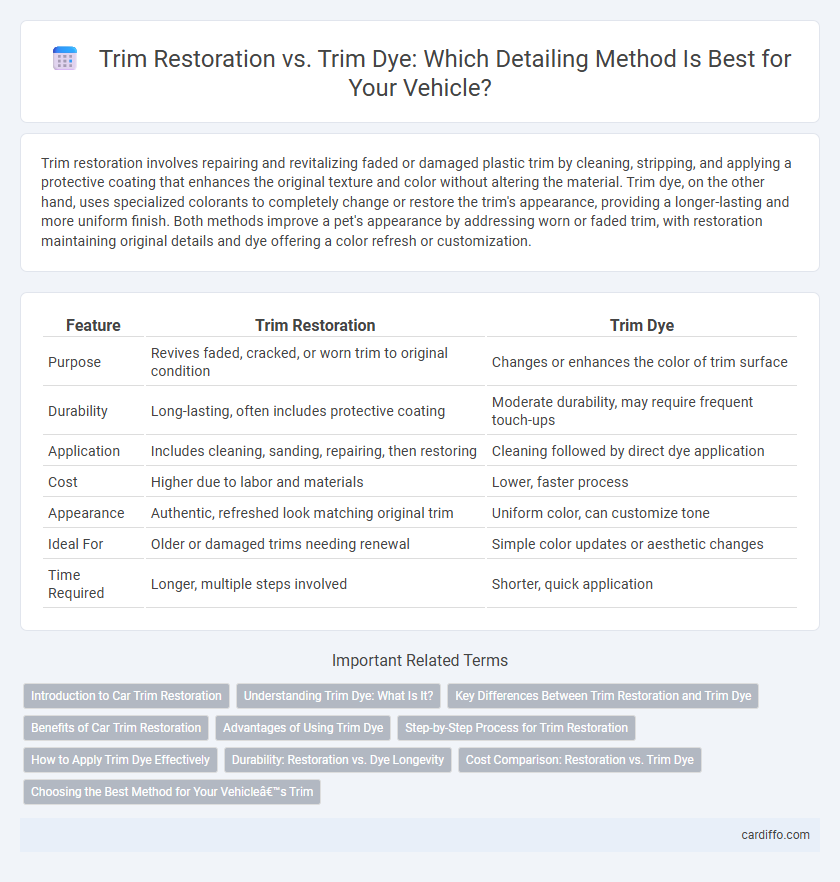Trim restoration involves repairing and revitalizing faded or damaged plastic trim by cleaning, stripping, and applying a protective coating that enhances the original texture and color without altering the material. Trim dye, on the other hand, uses specialized colorants to completely change or restore the trim's appearance, providing a longer-lasting and more uniform finish. Both methods improve a pet's appearance by addressing worn or faded trim, with restoration maintaining original details and dye offering a color refresh or customization.
Table of Comparison
| Feature | Trim Restoration | Trim Dye |
|---|---|---|
| Purpose | Revives faded, cracked, or worn trim to original condition | Changes or enhances the color of trim surface |
| Durability | Long-lasting, often includes protective coating | Moderate durability, may require frequent touch-ups |
| Application | Includes cleaning, sanding, repairing, then restoring | Cleaning followed by direct dye application |
| Cost | Higher due to labor and materials | Lower, faster process |
| Appearance | Authentic, refreshed look matching original trim | Uniform color, can customize tone |
| Ideal For | Older or damaged trims needing renewal | Simple color updates or aesthetic changes |
| Time Required | Longer, multiple steps involved | Shorter, quick application |
Introduction to Car Trim Restoration
Car trim restoration enhances the aesthetic and value of your vehicle by repairing faded, cracked, or worn exterior trim pieces. Unlike trim dye, which simply recolors the surface, restoration involves cleaning, repairing, and protecting trim materials for a longer-lasting and factory-fresh appearance. Professional trim restoration products typically include specialized cleaners, conditioners, and sealants designed to restore vinyl, rubber, and plastic components effectively.
Understanding Trim Dye: What Is It?
Trim dye is a specialized automotive product designed to restore the original color and finish of plastic or vinyl exterior trim pieces. Unlike trim restoration, which involves cleaning and polishing to improve appearance, trim dye penetrates and recolors faded or discolored surfaces, providing a durable, long-lasting color refresh. This process is ideal for reviving the look of bumpers, molding, and other faded trim components without the need for costly replacement parts.
Key Differences Between Trim Restoration and Trim Dye
Trim restoration involves repairing and rejuvenating damaged or faded trim using cleaning, sanding, and protective coatings, while trim dye focuses on applying color to restore or change the trim's appearance. Trim restoration enhances durability and surface texture by addressing imperfections, whereas trim dye primarily improves aesthetics by replenishing color without altering the trim's physical condition. The choice between these methods depends on the trim's overall wear and desired outcome, with restoration suited for deeper damage and dye ideal for color refreshment.
Benefits of Car Trim Restoration
Car trim restoration enhances vehicle appearance by removing scratches, fading, and oxidation, resulting in a like-new finish without the need for complete trim replacement. This process saves money compared to trim dye by preserving the original material, maintaining factory texture and shine while improving durability against UV damage and environmental wear. Restoration also boosts resale value by restoring the car's aesthetic appeal in a cost-effective and environmentally friendly manner.
Advantages of Using Trim Dye
Trim dye offers a cost-effective and long-lasting solution for restoring faded or discolored automotive trim, providing uniform color penetration that resists chipping and peeling better than traditional trim restoration sprays. It revitalizes plastic and rubber surfaces by penetrating deeply, ensuring enhanced durability and a factory-fresh appearance. Using trim dye also reduces the need for frequent touch-ups, making it a preferred choice for maintaining the vehicle's aesthetic value over time.
Step-by-Step Process for Trim Restoration
Trim restoration involves a meticulous step-by-step process starting with thorough cleaning to remove dirt and oxidation from the trim surface. Next, sanding smooths out imperfections while ensuring proper adhesion, followed by applying multiple coats of a specialized restoration product to restore the original color and texture. The process concludes with a protective clear sealant that enhances durability and UV resistance, providing long-lasting results compared to trim dyeing.
How to Apply Trim Dye Effectively
To apply trim dye effectively, start by thoroughly cleaning the surface with a dedicated trim cleaner to remove dirt, grease, and old residues for optimal dye adhesion. Use a high-quality applicator pad to evenly spread the dye in thin layers, ensuring better absorption and a uniform finish that mimics the original trim color. Allow each coat to dry completely before applying additional layers to achieve a durable and professional-looking restoration.
Durability: Restoration vs. Dye Longevity
Trim restoration offers superior durability by repairing and resurfacing the trim material, often restoring it to its original condition and extending its lifespan significantly. In contrast, trim dye primarily provides a cosmetic color refresh that can fade or peel within months, especially when exposed to sunlight and harsh weather. Choosing restoration over dye ensures longer-lasting protection against cracking, fading, and wear, preserving trim appearance effectively.
Cost Comparison: Restoration vs. Trim Dye
Trim restoration typically incurs higher upfront costs, ranging from $150 to $350 depending on the vehicle and extent of damage, due to labor-intensive cleaning, sanding, and sealing processes. Trim dye offers a more budget-friendly alternative, averaging $50 to $150, but may require more frequent reapplication as it primarily masks fading rather than repairing surface damage. Cost-effectiveness depends on the desired longevity and quality, with restoration providing a longer-lasting solution while trim dye suits short-term aesthetic improvements.
Choosing the Best Method for Your Vehicle’s Trim
Trim restoration involves repairing and recoloring faded or damaged trim using high-quality products that restore the original texture and color, making it ideal for maintaining factory finishes. Trim dye penetrates the plastic, offering a deeper, longer-lasting color change suitable for extensive fading or customized looks. Selecting between restoration and dye depends on the trim's condition, desired durability, and whether preserving the original finish or achieving a new color is the priority.
Trim Restoration vs Trim Dye Infographic

 cardiffo.com
cardiffo.com